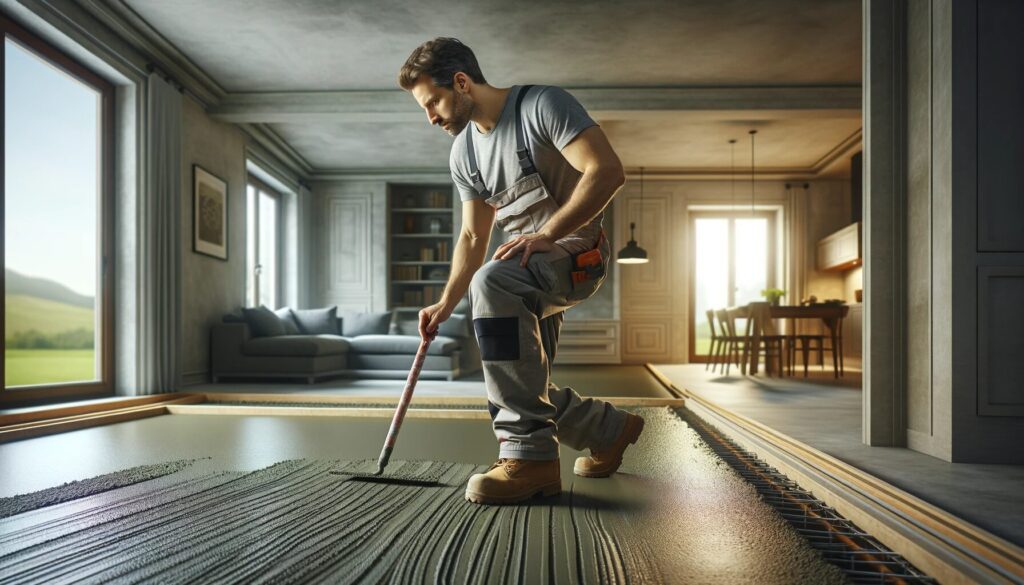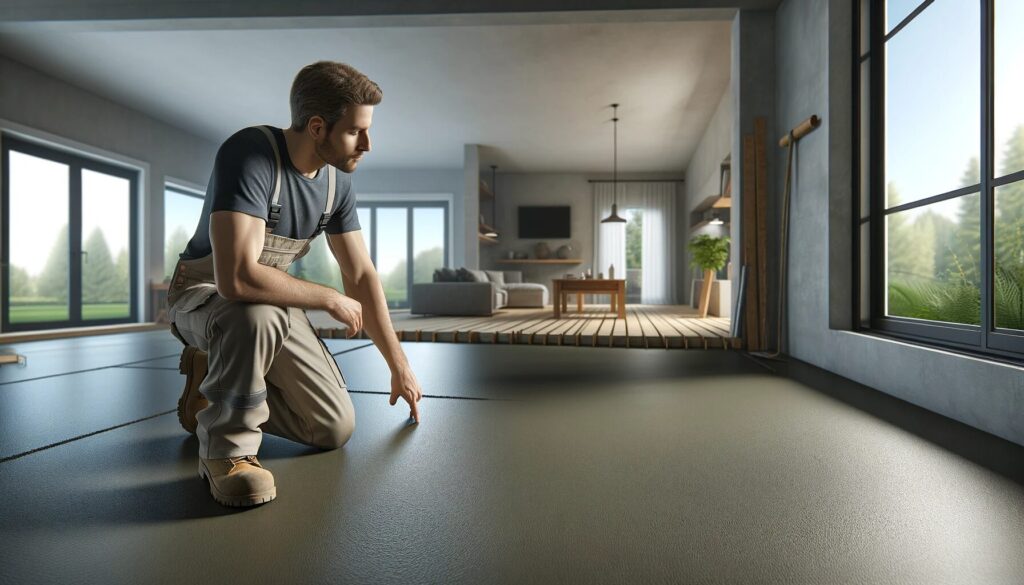Concrete flooring, a once purely industrial option, has now become a sought-after choice for homeowners and builders alike. The versatility and modern appeal of concrete floors have seen a meteoric rise in residential spaces, proving that functionality and aesthetics can indeed go hand in hand. This trend marks a significant shift in home design, reflecting a growing appreciation for materials that offer both practicality and a touch of sophistication.
Understanding the audience’s perspective is crucial – they’re looking for flooring solutions that blend durability, ease of maintenance, and a flair for design. Concrete floors, with their myriad of finishes and styles, offer an answer to these needs, bringing a unique blend of resilience and elegance to living spaces.

The Basics of Concrete Flooring
Concrete flooring is essentially a mixture of cement, water, and aggregate, forming a robust and versatile surface. This simple composition belies the strength and adaptability of the material. Historically, concrete has been a staple in commercial and industrial settings due to its durability. However, its transition into residential spaces is a testament to its evolving nature, showcasing its ability to adapt to various aesthetic demands without losing its inherent strengths.
Advantages of Choosing Concrete Floors
- Durability and Longevity: One of the paramount benefits of concrete floors is their resilience. Capable of withstanding heavy foot traffic, spills, and impacts, these floors are an investment in longevity. Their hard-wearing nature makes them an ideal choice for areas that see frequent use, ensuring they remain in prime condition for years.
- Low Maintenance: The ease of upkeep with concrete floors is a significant advantage. Unlike more delicate flooring options, concrete requires minimal maintenance – a regular sweep and a mop are generally all that’s needed to keep these floors looking their best. This simplicity in maintenance is not only a time-saver but also makes concrete floors a practical option for busy households.
- Versatility in Design: Perhaps the most surprising aspect of concrete floors is their aesthetic versatility. With a range of finishes including polished, stained, and textured options, concrete can be customized to suit any interior design scheme. This chameleon-like ability allows homeowners to achieve a variety of looks – from sleek and modern to warm and rustic.
- Environmental Benefits: For those conscious of their environmental impact, concrete floors are an attractive option. They often utilize existing materials and can incorporate recycled components, reducing waste and resource consumption. Their thermal mass properties also contribute to energy efficiency, aiding in regulating indoor temperatures and reducing the need for extensive heating and cooling.
Installation and Preparation
When it comes to installing a concrete floor, preparation is key. It’s like laying down the foundation for success. The process begins with a thorough examination of your base floor or substrate. Make sure it’s clean, level, and free from any cracks or defects. This initial step is crucial, as any imperfections can affect the final outcome.
Here’s a practical list of tools and materials you’ll need:
- Concrete mix: Choose the right type for your project, be it a standard mix or a high-performance option.
- Trowels and floats: Essential for spreading and smoothing the concrete.
- Mixing tools: A mixer is highly recommended to ensure a consistent mix.
- Safety gear: Don’t skimp on gloves, goggles, and a dust mask. Safety first.
Once your substrate is prepped and your materials are at hand, mix your concrete following the manufacturer’s guidelines. Pour the mix onto your surface, spreading it evenly with a trowel. It’s important to keep the surface level and work out any air pockets.
After laying the concrete, it needs time to cure. This process can take several days and is critical to the floor’s durability. Throughout this phase, patience is your best friend.

Design Options and Creative Uses
Concrete floors offer an exciting canvas for creativity. The range of finishes available can transform the aesthetic of any room.
Consider these options:
- Polished finish for a sleek, glossy look, ideal for modern settings.
- Stained concrete, offering a spectrum of color possibilities that can add warmth and personality.
- Textured finishes for added grip and visual interest.
- Colored concrete, where pigments are mixed into the concrete for a consistent hue throughout.
Each room in your house can benefit from the unique appeal of concrete:
- In kitchens, a polished finish not only looks clean and contemporary but is also easy to maintain.
- Living rooms can be elevated with stained concrete, providing a cozy yet sophisticated ambiance.
- For garages, a textured finish is practical, providing durability and better traction.
Concrete’s neutral tone harmonizes well with various decorative elements. It can be softened with rugs in living spaces or contrasted with wood accents for a blend of natural and industrial themes.

Maintenance and Care
Maintaining a concrete floor is straightforward but essential for its longevity and appearance.
Regular maintenance involves:
- Routine sweeping and damp mopping with a pH-neutral cleaner to keep the surface clean and attractive.
- Avoiding harsh chemicals that can damage the floor’s finish.
Long-term care includes:
- Applying a sealant every few years to maintain its waterproof qualities and aesthetic appeal.
- Periodic re-polishing to rejuvenate its appearance.
Addressing common issues:
- Small cracks might appear over time. These are usually superficial but should be filled in to prevent them from expanding.
- For colored or stained floors, be aware of potential fading. Regular sealing helps preserve the color, but touch-ups may be needed occasionally.
Cost Analysis
In the realm of home construction, understanding the costs associated with installing and maintaining concrete floors is crucial for making informed decisions. The overall expenditure can be broken down into several components:
- Materials: This includes the cost of the concrete mix, any necessary reinforcements like wire mesh, and finishing materials. While these costs can vary, concrete is generally more affordable than luxury materials like marble or high-end wood.
- Labor: For those not adept in the DIY approach, labor can constitute a significant portion of the cost. This depends on the complexity of the job and regional labor rates.
- Maintenance: Concrete floors require some upkeep, though relatively minimal. Periodic sealing and occasional polishing are typical requirements.
When compared to other popular flooring options such as hardwood or ceramic tiles, concrete often emerges as a cost-effective choice in the long term, thanks to its durability and minimal maintenance needs.
Real-Life Applications and Case Studies
Concrete flooring is a versatile option, finding its place in various settings, both residential and commercial. Here are a few examples from my experience:
- In a family home, where a beautifully stained concrete floor added warmth and character to the living space.
- A local coffee shop opted for a polished concrete floor, achieving an urban, industrial look that was both stylish and practical.
- A homeowner transformed their garage into a workshop, where the concrete floor could withstand heavy machinery and spills without issue.
Feedback from homeowners and construction professionals often highlights the durability, low maintenance, and aesthetic versatility of concrete floors, making them a popular choice in diverse projects.
FAQ Section
A well-installed and properly maintained concrete floor can last for decades, even a lifetime. Key factors include quality installation and regular maintenance, such as sealing and cleaning.
Yes, but it depends on the condition and type of the existing flooring. In some cases, a new subfloor or preparation of the existing floor may be necessary.
Concrete can crack, typically due to structural settling or installation issues. However, these are often minor and can be repaired or even incorporated into the design.
The customization options for concrete floors are extensive. From stains and dyes to different finishes and textures, concrete floors can be tailored to fit a wide range of aesthetic preferences.
Absolutely. Concrete floors are durable, easy to clean, and can be treated with non-slip finishes, making them suitable for households with pets and children.
Concrete flooring has both pros and cons environmentally. On one hand, its production is energy-intensive, on the other, its durability and energy efficiency (due to its thermal mass properties) can contribute positively over its lifespan.
